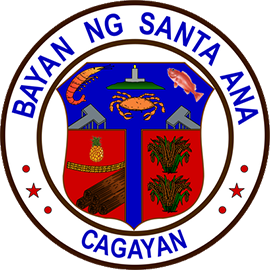The place now called the Municipality of Santa Ana was formerly called “Palawig”. Its first inhabitants were the Negritoes and “Hacheros” (meaning woodcutters) under the Don Julian Astigarraga, a concessionaire from Aparri.
In 1917, a group of Ilocanos came to San Vicente to survey agricultural lands. Seeing that the place is suitable for farming, they filed homestead applications but were disapproved.
When Gonzaga, the mother town, was created in 1918, Pedro Agarpao and son Felipe with some other fishermen from Minanga (still a barangay of Gonzaga today) settled at the river banks of Palawig (from the negrito word “pasawig,” meaning “mouth of the river”). From thence, “Palawig” became the popular name of the place.
In 1919, Felipe Agarpao with some settlers organized a “gimong” (meaning association) called “Inanama.” The purpose of this organization was to acquire and occupy lands around the place. Soon, Briccio Campañero of Lapog, Ilocos Sur together with some others from Ilocos, came to Palawig to apply for homesteads in the sitio of Marede. Through the leadership of Federico Navarro, six homesteads were approved for the settlers of Marede. These settlers organized another “gimong” called “Dagupan.” The same was so called because the members came from different places.
The fruit of the labor came only in 1949. The municipality was created by virtue of Executive Order No. 289 signed by then President Elpidio Quirino on October 21, 1949. “Palawig” and other barrios were separated from the municipality of Gonzaga effective January 1, 1950 and at the same time it was then called Santa Ana.
Santa Ana Ana was not named after a saint who triumphed over a sin. It emerged from the figment of the minds of three great men whose family names begin with letters which spell the word ANA of former governor Arranz and Board Members Navarro and Avena, who were the incumbent provincial officials during the birth of Santa Ana.
Creation
In 1935, the groups “Inanama” and “Dagupan” fused into one called “Da Inanama.” The members thought it wise to work for the separation of Palawig from its surrounding barrios and become a municipality independent from Gonzaga. Application and other necessary papers were submitted to the Municipal Council of Gonzaga, which in turn endorsed them to the Department of Interior and Local Government. The committee received an answer stating that the application for a new municipality was held in abeyance because the population of 3,000 did not meet the needed 5,000 population as required by law.
During that time, settlers hiked to Santa Ana and others came by water transport using boats considering the national road was underdeveloped. Hence, it was one of the main causes of the slow increase in the number of population.
A national road from Dugo, Camalaniugan to San Vicente (DSVR) was constructed and later it was opened two years before the war in 1941. However, the move to make “Palawig” as a municipality was not pushed through because of the outbreak of World War II.
Socio-economic and Political Development
In 1946, someone named Navarro was appointed Mayor of the municipality of Gonzaga, he resumed his project to work for the separation of Palawig from Gonzaga. As member of the provincial board in 1947, he continued to work on the same, aided by the members of the provincial board.
Due to the conflict of boundary between Gonzaga and new Santa Ana, it was only on March 6, 1950 when the new municipality was inaugurated. The first appointed Mayor was Venerando Udarbe, Sr. and Elpidio A. Tobias, Sr., Vice Mayor. The first appointed councilors were Sulpicio Leaño, Jose Manzano, Rosendo Medrano, and Toribio Peneyra.
The first town hall was located in the heart of Palawig at the house of former councilor Pantaleon Recolizado. It was only in early 1956 when the construction of the present town hall at the new site was started through the initiative of the appointed Municipal Officials. On June 1, 1957 the municipal government was transferred to its present home, serving as the administrative seat of its sixteen (16) barangays.




